Convolutional Neural Network
Experimental environment
keras 2.1.5
tensorflow 1.4.0
Experimental tools
Jupyter Notebook
Experiment 1: Handwritten Number Classification
Experimental purpose
Grayscale images of handwritten numbers (28 pixels by 28 pixels) are classified into 10 categories (0 to 9).
data set
MNIST dataset:
MNIST dataset is a classic dataset in the field of machine learning.This is a set of 60,000 training images plus 10,000 test images developed by the National Institute of Standards and Technology (NIST) in the 1980s.You can think of solving MNIST classification problems as Hello World for in-depth learning.
Experimental process
1. Basic structure of convolution neural networks:
It is a series of two-dimensional convolution layers and two-dimensional maximum pooling layers.
Importantly, a convolution network requires input of shapeful tensors (image height, image width, image channel) (excluding the dimension of batch processing).In this example, the input of the convolution network processing size (28,28,1) will be set, which is the format of the mnist image.We do this by transferring the parameter input_shape=(28, 28, 1) to the first layer.
from keras import layers from keras import models model = models.Sequential() model.add(layers.Conv2D(32, (3, 3), activation='relu', input_shape=(28, 28, 1))) model.add(layers.MaxPooling2D((2, 2))) model.add(layers.Conv2D(64, (3, 3), activation='relu')) model.add(layers.MaxPooling2D((2, 2))) model.add(layers.Conv2D(64, (3, 3), activation='relu'))
2. Specific architecture of convolution network:
model.summary() ''' _________________________________________________________________ Layer (type) Output Shape Param # ================================================================= conv2d_1 (Conv2D) (None, 26, 26, 32) 320 _________________________________________________________________ max_pooling2d_1 (MaxPooling2 (None, 13, 13, 32) 0 _________________________________________________________________ conv2d_2 (Conv2D) (None, 11, 11, 64) 18496 _________________________________________________________________ max_pooling2d_2 (MaxPooling2 (None, 5, 5, 64) 0 _________________________________________________________________ conv2d_3 (Conv2D) (None, 3, 3, 64) 36928 ================================================================= Total params: 55,744 Trainable params: 55,744 Non-trainable params: 0 _________________________________________________________________ ''' #The output of each two-dimensional convolution layer and the two-dimensional maximum pooled layer is a three-dimensional shape tensor (height, width, number of channels).As the network goes deeper, the width and height shrink.The number of channels passed from one to two dimensions #The first parameter control of the convolution layer (for example, 32 or 64).
3. Enter our last output tensor (shape (3,3,64)) into a densely connected classification network:
These classifiers deal with vectors that are one-dimensional, and our output now is a three-dimensional tensor.Therefore, first we flatten the three-dimensional output to one dimension, then add some dense layers at the top:
model.add(layers.Flatten()) model.add(layers.Dense(64, activation='relu')) model.add(layers.Dense(10, activation='softmax')) model.summary() ''' _________________________________________________________________ Layer (type) Output Shape Param # ================================================================= conv2d_1 (Conv2D) (None, 26, 26, 32) 320 _________________________________________________________________ max_pooling2d_1 (MaxPooling2 (None, 13, 13, 32) 0 _________________________________________________________________ conv2d_2 (Conv2D) (None, 11, 11, 64) 18496 _________________________________________________________________ max_pooling2d_2 (MaxPooling2 (None, 5, 5, 64) 0 _________________________________________________________________ conv2d_3 (Conv2D) (None, 3, 3, 64) 36928 _________________________________________________________________ flatten_1 (Flatten) (None, 576) 0 _________________________________________________________________ dense_1 (Dense) (None, 64) 36928 _________________________________________________________________ dense_2 (Dense) (None, 10) 650 ================================================================= Total params: 93,322 Trainable params: 93,322 Non-trainable params: 0 _________________________________________________________________ '''
4. Training:
from keras.datasets import mnist from keras.utils import to_categorical (train_images, train_labels), (test_images, test_labels) = mnist.load_data() train_images = train_images.reshape((60000, 28, 28, 1)) train_images = train_images.astype('float32') / 255 test_images = test_images.reshape((10000, 28, 28, 1)) test_images = test_images.astype('float32') / 255 train_labels = to_categorical(train_labels) test_labels = to_categorical(test_labels) model.compile(optimizer='rmsprop', loss='categorical_crossentropy', metrics=['accuracy']) model.fit(train_images, train_labels, epochs=5, batch_size=64) ''' Epoch 1/5 60000/60000 [==============================] - 160s 3ms/step - loss: 0.1797 - acc: 0.9438 Epoch 2/5 60000/60000 [==============================] - 163s 3ms/step - loss: 0.0474 - acc: 0.9857 Epoch 3/5 60000/60000 [==============================] - 8673s 145ms/step - loss: 0.0327 - acc: 0.9896 Epoch 4/5 60000/60000 [==============================] - 39s 647us/step - loss: 0.0248 - acc: 0.9924 Epoch 5/5 60000/60000 [==============================] - 37s 615us/step - loss: 0.0196 - acc: 0.9942 <keras.callbacks.History at 0x1fac5e8cf60> '''
5. Assessment:
test_loss, test_acc = model.evaluate(test_images, test_labels) ''' 10000/10000 [==============================] - 3s 255us/step ''' test_acc ''' 0.99019999999999997 ''' #The test accuracy reached an astonishing 99.1%.
Code Integration
from keras import layers from keras import models model = models.Sequential() model.add(layers.Conv2D(32, (3, 3), activation='relu', input_shape=(28, 28, 1))) model.add(layers.MaxPooling2D((2, 2))) model.add(layers.Conv2D(64, (3, 3), activation='relu')) model.add(layers.MaxPooling2D((2, 2))) model.add(layers.Conv2D(64, (3, 3), activation='relu')) model.summary() model.add(layers.Flatten()) model.add(layers.Dense(64, activation='relu')) model.add(layers.Dense(10, activation='softmax')) model.summary() from keras.datasets import mnist from keras.utils import to_categorical (train_images, train_labels), (test_images, test_labels) = mnist.load_data() train_images = train_images.reshape((60000, 28, 28, 1)) train_images = train_images.astype('float32') / 255 test_images = test_images.reshape((10000, 28, 28, 1)) test_images = test_images.astype('float32') / 255 train_labels = to_categorical(train_labels) test_labels = to_categorical(test_labels) model.compile(optimizer='rmsprop', loss='categorical_crossentropy', metrics=['accuracy']) model.fit(train_images, train_labels, epochs=5, batch_size=64) test_loss, test_acc = model.evaluate(test_images, test_labels) test_acc
Experiment 2: Convolutional neural networks using small datasets
Experimental purpose
In a dataset containing 4,000 images of cats and dogs (2,000 cats and 2,000 dogs), the images were classified as "dog" or "cat".
data set
Cat and Dog Dataset:
This original dataset contains 25,000 images of dogs and cats (12,500 per course) and is 543 MB in size (compressed).After downloading and decompressing, we will create a new dataset with three subsets: a training set of 1000 samples per class, a validation set of 500 samples per class, and a test set of 500 samples per class.
Experimental process
1. Download the dataset:
Create a new dataset that contains three subsets: a training set of 1000 samples per class, a validation set of 500 samples per class, and a test set of 500 samples per class.
import os, shutil original_dataset_dir = 'kaggle_original_data/train' # The directory where we will # store our smaller dataset base_dir = 'cats_and_dogs_small' os.mkdir(base_dir) train_dir = os.path.join(base_dir, 'train') os.mkdir(train_dir) validation_dir = os.path.join(base_dir, 'validation') os.mkdir(validation_dir) test_dir = os.path.join(base_dir, 'test') os.mkdir(test_dir) train_cats_dir = os.path.join(train_dir, 'cats') os.mkdir(train_cats_dir) train_dogs_dir = os.path.join(train_dir, 'dogs') os.mkdir(train_dogs_dir) validation_cats_dir = os.path.join(validation_dir, 'cats') os.mkdir(validation_cats_dir) validation_dogs_dir = os.path.join(validation_dir, 'dogs') os.mkdir(validation_dogs_dir) test_cats_dir = os.path.join(test_dir, 'cats') os.mkdir(test_cats_dir) test_dogs_dir = os.path.join(test_dir, 'dogs') os.mkdir(test_dogs_dir) # fnames = ['cat.{}.jpg'.format(i) for i in range(1000)] for fname in fnames: src = os.path.join(original_dataset_dir, fname) dst = os.path.join(train_cats_dir, fname) shutil.copyfile(src, dst) # Copy next 500 cat images to validation_cats_dir fnames = ['cat.{}.jpg'.format(i) for i in range(1000, 1500)] for fname in fnames: src = os.path.join(original_dataset_dir, fname) dst = os.path.join(validation_cats_dir, fname) shutil.copyfile(src, dst) # Copy next 500 cat images to test_cats_dir fnames = ['cat.{}.jpg'.format(i) for i in range(1500, 2000)] for fname in fnames: src = os.path.join(original_dataset_dir, fname) dst = os.path.join(test_cats_dir, fname) shutil.copyfile(src, dst) # Copy first 1000 dog images to train_dogs_dir fnames = ['dog.{}.jpg'.format(i) for i in range(1000)] for fname in fnames: src = os.path.join(original_dataset_dir, fname) dst = os.path.join(train_dogs_dir, fname) shutil.copyfile(src, dst) # Copy next 500 dog images to validation_dogs_dir fnames = ['dog.{}.jpg'.format(i) for i in range(1000, 1500)] for fname in fnames: src = os.path.join(original_dataset_dir, fname) dst = os.path.join(validation_dogs_dir, fname) shutil.copyfile(src, dst) # Copy next 500 dog images to test_dogs_dir fnames = ['dog.{}.jpg'.format(i) for i in range(1500, 2000)] for fname in fnames: src = os.path.join(original_dataset_dir, fname) dst = os.path.join(test_dogs_dir, fname) shutil.copyfile(src, dst) print('total training cat images:', len(os.listdir(train_cats_dir))) ''' total training cat images: 1000 ''' print('total training dog images:', len(os.listdir(train_dogs_dir))) ''' total training dog images: 1000 ''' print('total validation cat images:', len(os.listdir(validation_cats_dir))) ''' total validation cat images: 500 ''' print('total validation dog images:', len(os.listdir(validation_dogs_dir))) ''' total validation dog images: 500 ''' print('total test cat images:', len(os.listdir(test_cats_dir))) ''' total test cat images: 500 ''' print('total test dog images:', len(os.listdir(test_dogs_dir))) ''' total test dog images: 500 '''
2. Set up a network:
Our convolution network is a stack of alternating Conv2D (with Relu activation) and Max pooled 2D layers, which will have a Conv2D + MaxPooling 2D phase and a single cell (full-connected layer of size 1) and a S-shape activation as network output layers to handle larger images and more complex problems.
from keras import layers from keras import models model = models.Sequential() model.add(layers.Conv2D(32, (3, 3), activation='relu', input_shape=(150, 150, 3))) model.add(layers.MaxPooling2D((2, 2))) model.add(layers.Conv2D(64, (3, 3), activation='relu')) model.add(layers.MaxPooling2D((2, 2))) model.add(layers.Conv2D(128, (3, 3), activation='relu')) model.add(layers.MaxPooling2D((2, 2))) model.add(layers.Conv2D(128, (3, 3), activation='relu')) model.add(layers.MaxPooling2D((2, 2))) model.add(layers.Flatten()) model.add(layers.Dense(512, activation='relu')) model.add(layers.Dense(1, activation='sigmoid')) model.summary() ''' _________________________________________________________________ Layer (type) Output Shape Param # ================================================================= conv2d_1 (Conv2D) (None, 148, 148, 32) 896 _________________________________________________________________ max_pooling2d_1 (MaxPooling2 (None, 74, 74, 32) 0 _________________________________________________________________ conv2d_2 (Conv2D) (None, 72, 72, 64) 18496 _________________________________________________________________ max_pooling2d_2 (MaxPooling2 (None, 36, 36, 64) 0 _________________________________________________________________ conv2d_3 (Conv2D) (None, 34, 34, 128) 73856 _________________________________________________________________ max_pooling2d_3 (MaxPooling2 (None, 17, 17, 128) 0 _________________________________________________________________ conv2d_4 (Conv2D) (None, 15, 15, 128) 147584 _________________________________________________________________ max_pooling2d_4 (MaxPooling2 (None, 7, 7, 128) 0 _________________________________________________________________ flatten_1 (Flatten) (None, 6272) 0 _________________________________________________________________ dense_1 (Dense) (None, 512) 3211776 _________________________________________________________________ dense_2 (Dense) (None, 1) 513 ================================================================= Total params: 3,453,121 Trainable params: 3,453,121 Non-trainable params: 0 _________________________________________________________________ '''
Using RMSprop optimizer:
Since the output layer of the network is a single simoid cell, the binary cross-entropy is used as our loss function.
from keras import optimizers model.compile(loss='binary_crossentropy', optimizer=optimizers.RMSprop(lr=1e-4), metrics=['acc'])
4. Data preprocessing:
Preprocessed floating-point tensors should be used to format data before entering our network.
The steps to import it into our network are as follows:
1. Read picture files
2. Decode JPEG content into a RBG grid of pixels.
3. Convert these to floating-point tensors.
4. Rescale the pixel values (between 0 and 255) to [0,1] intervals (as you know, neural networks tend to handle small input values).
from keras.preprocessing.image import ImageDataGenerator # All images will be rescaled by 1./255 train_datagen = ImageDataGenerator(rescale=1./255) test_datagen = ImageDataGenerator(rescale=1./255) train_generator = train_datagen.flow_from_directory( # This is the target directory train_dir, # All images will be resized to 150x150 target_size=(150, 150), batch_size=20, # Since we use binary_crossentropy loss, we need binary labels class_mode='binary') validation_generator = test_datagen.flow_from_directory( validation_dir, target_size=(150, 150), batch_size=20, class_mode='binary') ''' Found 2000 images belonging to 2 classes. Found 1000 images belonging to 2 classes. ''' #View the output of one of the generators: #It produces batches of 150x150 RGB images (shapes (20,150,150,3)) and binary labels (shapes (20,)).20 is the number of samples in each batch (batch size). for data_batch, labels_batch in train_generator: print('data batch shape:', data_batch.shape) print('labels batch shape:', labels_batch.shape) break ''' data batch shape: (20, 150, 150, 3) labels batch shape: (20,) '''
5. Fitting:
Using the Fit Generator method.
history = model.fit_generator( train_generator, steps_per_epoch=100, epochs=30, validation_data=validation_generator, validation_steps=50) ''' Epoch 1/30 100/100 [==============================] - 1269s 13s/step - loss: 0.6859 - acc: 0.5475 - val_loss: 0.6616 - val_acc: 0.6420 Epoch 2/30 100/100 [==============================] - 27s 269ms/step - loss: 0.6353 - acc: 0.6390 - val_loss: 0.6266 - val_acc: 0.6590 Epoch 3/30 100/100 [==============================] - 24s 237ms/step - loss: 0.5914 - acc: 0.6910 - val_loss: 0.6410 - val_acc: 0.6390 Epoch 4/30 100/100 [==============================] - 24s 240ms/step - loss: 0.5601 - acc: 0.7165 - val_loss: 0.6574 - val_acc: 0.6340 Epoch 5/30 100/100 [==============================] - 25s 248ms/step - loss: 0.5373 - acc: 0.7265 - val_loss: 0.6056 - val_acc: 0.6720 Epoch 6/30 100/100 [==============================] - 20s 195ms/step - loss: 0.5116 - acc: 0.7505 - val_loss: 0.5675 - val_acc: 0.6990 Epoch 7/30 100/100 [==============================] - 20s 196ms/step - loss: 0.4860 - acc: 0.7560 - val_loss: 0.5564 - val_acc: 0.6980 Epoch 8/30 100/100 [==============================] - 20s 202ms/step - loss: 0.4555 - acc: 0.7840 - val_loss: 0.5694 - val_acc: 0.7020 Epoch 9/30 100/100 [==============================] - 23s 233ms/step - loss: 0.4339 - acc: 0.7990 - val_loss: 0.5547 - val_acc: 0.7100 Epoch 10/30 100/100 [==============================] - 21s 208ms/step - loss: 0.4034 - acc: 0.8185 - val_loss: 0.5484 - val_acc: 0.7280 Epoch 11/30 100/100 [==============================] - 22s 217ms/step - loss: 0.3810 - acc: 0.8295 - val_loss: 0.5737 - val_acc: 0.7220 Epoch 12/30 100/100 [==============================] - 22s 218ms/step - loss: 0.3609 - acc: 0.8455 - val_loss: 0.6161 - val_acc: 0.7010 Epoch 13/30 100/100 [==============================] - 21s 208ms/step - loss: 0.3415 - acc: 0.8470 - val_loss: 0.5498 - val_acc: 0.7260 Epoch 14/30 100/100 [==============================] - 20s 205ms/step - loss: 0.3190 - acc: 0.8640 - val_loss: 0.5676 - val_acc: 0.7250 Epoch 15/30 100/100 [==============================] - 20s 204ms/step - loss: 0.2891 - acc: 0.8865 - val_loss: 0.5854 - val_acc: 0.7420 Epoch 16/30 100/100 [==============================] - 21s 205ms/step - loss: 0.2694 - acc: 0.8890 - val_loss: 0.5864 - val_acc: 0.7290 Epoch 17/30 100/100 [==============================] - 20s 203ms/step - loss: 0.2471 - acc: 0.9015 - val_loss: 0.6189 - val_acc: 0.7210 Epoch 18/30 100/100 [==============================] - 25s 248ms/step - loss: 0.2318 - acc: 0.9105 - val_loss: 0.6030 - val_acc: 0.7300 Epoch 19/30 100/100 [==============================] - 23s 227ms/step - loss: 0.2075 - acc: 0.9220 - val_loss: 0.8091 - val_acc: 0.6860 Epoch 20/30 100/100 [==============================] - 24s 236ms/step - loss: 0.1872 - acc: 0.9350 - val_loss: 0.6385 - val_acc: 0.7480 Epoch 21/30 100/100 [==============================] - 22s 220ms/step - loss: 0.1730 - acc: 0.9435 - val_loss: 0.6707 - val_acc: 0.7330 Epoch 22/30 100/100 [==============================] - 27s 267ms/step - loss: 0.1569 - acc: 0.9465 - val_loss: 0.6582 - val_acc: 0.7440 Epoch 23/30 100/100 [==============================] - 25s 246ms/step - loss: 0.1438 - acc: 0.9485 - val_loss: 0.6917 - val_acc: 0.7460 Epoch 24/30 100/100 [==============================] - 28s 284ms/step - loss: 0.1239 - acc: 0.9585 - val_loss: 0.7309 - val_acc: 0.7400 Epoch 25/30 100/100 [==============================] - 24s 245ms/step - loss: 0.1099 - acc: 0.9625 - val_loss: 0.7476 - val_acc: 0.7290 Epoch 26/30 100/100 [==============================] - 25s 248ms/step - loss: 0.0936 - acc: 0.9700 - val_loss: 0.7722 - val_acc: 0.7390 Epoch 27/30 100/100 [==============================] - 21s 210ms/step - loss: 0.0811 - acc: 0.9740 - val_loss: 1.1478 - val_acc: 0.6940 Epoch 28/30 100/100 [==============================] - 21s 209ms/step - loss: 0.0717 - acc: 0.9780 - val_loss: 0.9114 - val_acc: 0.7130 Epoch 29/30 100/100 [==============================] - 21s 214ms/step - loss: 0.0634 - acc: 0.9800 - val_loss: 0.8197 - val_acc: 0.7400 Epoch 30/30 100/100 [==============================] - 22s 218ms/step - loss: 0.0561 - acc: 0.9840 - val_loss: 0.8574 - val_acc: 0.7360 ''' #Save Model model.save('cats_and_dogs_small_1.h5')
6. Draw the loss function and accuracy in the training and validation sets:
Overfitting occurred.
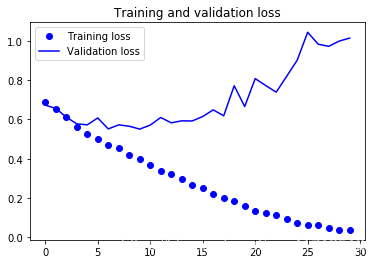
7. Data Enhancement:
Fitting is caused by not having too many samples to learn, which prevents us from training models that can be extended to new data.Given unlimited data, our model will cover every possible aspect of the distribution of the data at hand: we will never overuse it.Data enhancement uses the method of generating more training data from existing training samples and "enhances" the samples through some random transformations to produce reliable images.The goal is that during training, our model will never see the exact same picture again.This helps the model to cover more aspects of the data and to be more generalized.
#Configure a large number of random transformations datagen = ImageDataGenerator( rotation_range=40, #Randomly rotate the range of the picture width_shift_range=0.2, #Randomly transform the range of the picture vertically or horizontally height_shift_range=0.2, shear_range=0.2, #Random application of shear transformation zoom_range=0.2, #Random zoom of internal photos horizontal_flip=True, #Flip half of the image horizontally and randomly fill_mode='nearest') #Used to populate newly created pixels #View enhanced images from keras.preprocessing import image fnames = [os.path.join(train_cats_dir, fname) for fname in os.listdir(train_cats_dir)] img_path = fnames[3] img = image.load_img(img_path, target_size=(150, 150)) x = image.img_to_array(img) x = x.reshape((1,) + x.shape) i = 0 for batch in datagen.flow(x, batch_size=1): plt.figure(i) imgplot = plt.imshow(image.array_to_img(batch[0])) i += 1 if i % 4 == 0: break plt.show()
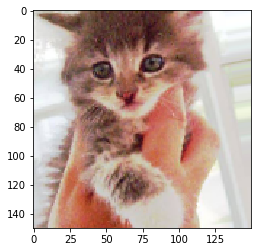
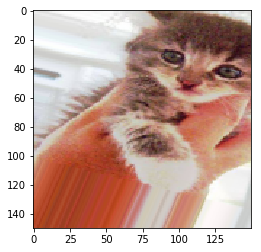
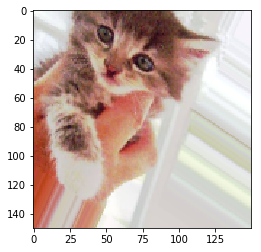
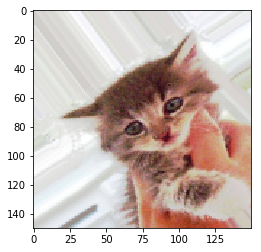
Inputs are still heavily correlated, so this may not be enough to get rid of fit completely.To further solve the fitting problem, we will also add a Dropout layer to the model before densely connected classifiers:
model = models.Sequential() model.add(layers.Conv2D(32, (3, 3), activation='relu', input_shape=(150, 150, 3))) model.add(layers.MaxPooling2D((2, 2))) model.add(layers.Conv2D(64, (3, 3), activation='relu')) model.add(layers.MaxPooling2D((2, 2))) model.add(layers.Conv2D(128, (3, 3), activation='relu')) model.add(layers.MaxPooling2D((2, 2))) model.add(layers.Conv2D(128, (3, 3), activation='relu')) model.add(layers.MaxPooling2D((2, 2))) model.add(layers.Flatten()) model.add(layers.Dropout(0.5)) model.add(layers.Dense(512, activation='relu')) model.add(layers.Dense(1, activation='sigmoid')) model.compile(loss='binary_crossentropy', optimizer=optimizers.RMSprop(lr=1e-4), metrics=['acc'])
8. Training network:
train_datagen = ImageDataGenerator( rescale=1./255, rotation_range=40, width_shift_range=0.2, height_shift_range=0.2, shear_range=0.2, zoom_range=0.2, horizontal_flip=True,) # Note that the validation data should not be augmented! test_datagen = ImageDataGenerator(rescale=1./255) train_generator = train_datagen.flow_from_directory( # This is the target directory train_dir, # All images will be resized to 150x150 target_size=(150, 150), batch_size=32, # Since we use binary_crossentropy loss, we need binary labels class_mode='binary') validation_generator = test_datagen.flow_from_directory( validation_dir, target_size=(150, 150), batch_size=32, class_mode='binary') history = model.fit_generator( train_generator, steps_per_epoch=100, epochs=10, validation_data=validation_generator, validation_steps=50) ''' Found 2000 images belonging to 2 classes. Found 1000 images belonging to 2 classes. Epoch 1/10 100/100 [==============================] - 65s 646ms/step - loss: 0.6938 - acc: 0.5212 - val_loss: 0.6851 - val_acc: 0.4956 Epoch 2/10 100/100 [==============================] - 57s 574ms/step - loss: 0.6838 - acc: 0.5513 - val_loss: 0.6942 - val_acc: 0.5089 Epoch 3/10 100/100 [==============================] - 57s 573ms/step - loss: 0.6700 - acc: 0.5828 - val_loss: 0.6439 - val_acc: 0.6136 Epoch 4/10 100/100 [==============================] - 57s 571ms/step - loss: 0.6478 - acc: 0.6275 - val_loss: 0.6255 - val_acc: 0.6225 Epoch 5/10 100/100 [==============================] - 59s 586ms/step - loss: 0.6324 - acc: 0.6428 - val_loss: 0.5974 - val_acc: 0.6834 Epoch 6/10 100/100 [==============================] - 60s 604ms/step - loss: 0.6126 - acc: 0.6678 - val_loss: 0.5896 - val_acc: 0.6593 Epoch 7/10 100/100 [==============================] - 66s 662ms/step - loss: 0.6132 - acc: 0.6597 - val_loss: 0.5620 - val_acc: 0.7164 Epoch 8/10 100/100 [==============================] - 57s 572ms/step - loss: 0.6044 - acc: 0.6672 - val_loss: 0.5758 - val_acc: 0.6872 Epoch 9/10 100/100 [==============================] - 76s 764ms/step - loss: 0.5782 - acc: 0.7094 - val_loss: 0.7336 - val_acc: 0.6148 Epoch 10/10 100/100 [==============================] - 87s 866ms/step - loss: 0.5931 - acc: 0.6788 - val_loss: 0.5397 - val_acc: 0.7253 ''' model.save('cats_and_dogs_small_2-10.h5')
9. Draw the result:
Due to data enhancement and discard strategies, we no longer overfit
acc = history.history['acc'] val_acc = history.history['val_acc'] loss = history.history['loss'] val_loss = history.history['val_loss'] epochs = range(len(acc)) plt.plot(epochs, acc, 'bo', label='Training acc') plt.plot(epochs, val_acc, 'b', label='Validation acc') plt.title('Training and validation accuracy') plt.legend() plt.figure() plt.plot(epochs, loss, 'bo', label='Training loss') plt.plot(epochs, val_loss, 'b', label='Validation loss') plt.title('Training and validation loss') plt.legend() plt.show()
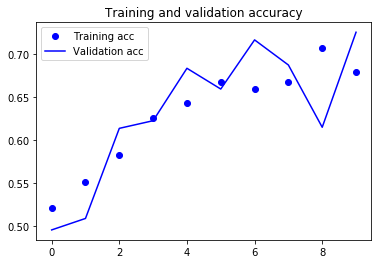
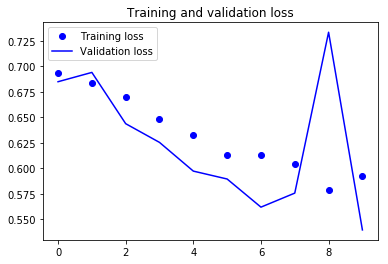
Code Integration
import keras keras.__version__ import os, shutil original_dataset_dir = 'kaggle_original_data/train' base_dir = 'cats_and_dogs_small' os.mkdir(base_dir) train_dir = os.path.join(base_dir, 'train') os.mkdir(train_dir) validation_dir = os.path.join(base_dir, 'validation') os.mkdir(validation_dir) test_dir = os.path.join(base_dir, 'test') os.mkdir(test_dir) train_cats_dir = os.path.join(train_dir, 'cats') os.mkdir(train_cats_dir) train_dogs_dir = os.path.join(train_dir, 'dogs') os.mkdir(train_dogs_dir) validation_cats_dir = os.path.join(validation_dir, 'cats') os.mkdir(validation_cats_dir) validation_dogs_dir = os.path.join(validation_dir, 'dogs') os.mkdir(validation_dogs_dir) test_cats_dir = os.path.join(test_dir, 'cats') os.mkdir(test_cats_dir) test_dogs_dir = os.path.join(test_dir, 'dogs') os.mkdir(test_dogs_dir) fnames = ['cat.{}.jpg'.format(i) for i in range(1000)] for fname in fnames: src = os.path.join(original_dataset_dir, fname) dst = os.path.join(train_cats_dir, fname) shutil.copyfile(src, dst) fnames = ['cat.{}.jpg'.format(i) for i in range(1000, 1500)] for fname in fnames: src = os.path.join(original_dataset_dir, fname) dst = os.path.join(validation_cats_dir, fname) shutil.copyfile(src, dst) fnames = ['cat.{}.jpg'.format(i) for i in range(1500, 2000)] for fname in fnames: src = os.path.join(original_dataset_dir, fname) dst = os.path.join(test_cats_dir, fname) shutil.copyfile(src, dst) fnames = ['dog.{}.jpg'.format(i) for i in range(1000)] for fname in fnames: src = os.path.join(original_dataset_dir, fname) dst = os.path.join(train_dogs_dir, fname) shutil.copyfile(src, dst) fnames = ['dog.{}.jpg'.format(i) for i in range(1000, 1500)] for fname in fnames: src = os.path.join(original_dataset_dir, fname) dst = os.path.join(validation_dogs_dir, fname) shutil.copyfile(src, dst) fnames = ['dog.{}.jpg'.format(i) for i in range(1500, 2000)] for fname in fnames: src = os.path.join(original_dataset_dir, fname) dst = os.path.join(test_dogs_dir, fname) shutil.copyfile(src, dst) from keras import layers from keras import models model = models.Sequential() model.add(layers.Conv2D(32, (3, 3), activation='relu', input_shape=(150, 150, 3))) model.add(layers.MaxPooling2D((2, 2))) model.add(layers.Conv2D(64, (3, 3), activation='relu')) model.add(layers.MaxPooling2D((2, 2))) model.add(layers.Conv2D(128, (3, 3), activation='relu')) model.add(layers.MaxPooling2D((2, 2))) model.add(layers.Conv2D(128, (3, 3), activation='relu')) model.add(layers.MaxPooling2D((2, 2))) model.add(layers.Flatten()) model.add(layers.Dense(512, activation='relu')) model.add(layers.Dense(1, activation='sigmoid')) from keras import optimizers model.compile(loss='binary_crossentropy', optimizer=optimizers.RMSprop(lr=1e-4), metrics=['acc']) from keras.preprocessing.image import ImageDataGenerator train_datagen = ImageDataGenerator(rescale=1./255) test_datagen = ImageDataGenerator(rescale=1./255) train_generator = train_datagen.flow_from_directory( train_dir, target_size=(150, 150), batch_size=20, class_mode='binary') validation_generator = test_datagen.flow_from_directory( validation_dir, target_size=(150, 150), batch_size=20, class_mode='binary') for data_batch, labels_batch in train_generator: print('data batch shape:', data_batch.shape) print('labels batch shape:', labels_batch.shape) break history = model.fit_generator( train_generator, steps_per_epoch=100, epochs=30, validation_data=validation_generator, validation_steps=50) datagen = ImageDataGenerator( rotation_range=40, width_shift_range=0.2, height_shift_range=0.2, shear_range=0.2, zoom_range=0.2, horizontal_flip=True, fill_mode='nearest') model = models.Sequential() model.add(layers.Conv2D(32, (3, 3), activation='relu', input_shape=(150, 150, 3))) model.add(layers.MaxPooling2D((2, 2))) model.add(layers.Conv2D(64, (3, 3), activation='relu')) model.add(layers.MaxPooling2D((2, 2))) model.add(layers.Conv2D(128, (3, 3), activation='relu')) model.add(layers.MaxPooling2D((2, 2))) model.add(layers.Conv2D(128, (3, 3), activation='relu')) model.add(layers.MaxPooling2D((2, 2))) model.add(layers.Flatten()) model.add(layers.Dropout(0.5)) model.add(layers.Dense(512, activation='relu')) model.add(layers.Dense(1, activation='sigmoid')) model.compile(loss='binary_crossentropy', optimizer=optimizers.RMSprop(lr=1e-4), metrics=['acc']) train_datagen = ImageDataGenerator( rescale=1./255, rotation_range=40, width_shift_range=0.2, height_shift_range=0.2, shear_range=0.2, zoom_range=0.2, horizontal_flip=True,) test_datagen = ImageDataGenerator(rescale=1./255) train_generator = train_datagen.flow_from_directory( # This is the target directory train_dir, # All images will be resized to 150x150 target_size=(150, 150), batch_size=32, # Since we use binary_crossentropy loss, we need binary labels class_mode='binary') validation_generator = test_datagen.flow_from_directory( validation_dir, target_size=(150, 150), batch_size=32, class_mode='binary') history = model.fit_generator( train_generator, steps_per_epoch=100, epochs=10, validation_data=validation_generator, validation_steps=50) acc = history.history['acc'] val_acc = history.history['val_acc'] loss = history.history['loss'] val_loss = history.history['val_loss'] epochs = range(len(acc)) plt.plot(epochs, acc, 'bo', label='Training acc') plt.plot(epochs, val_acc, 'b', label='Validation acc') plt.title('Training and validation accuracy') plt.legend() plt.figure() plt.plot(epochs, loss, 'bo', label='Training loss') plt.plot(epochs, val_loss, 'b', label='Validation loss') plt.title('Training and validation loss') plt.legend() plt.show()
Experiment 3: Using pre-training convnet
Experimental purpose
Classify ImageNet datasets using the VGG16 architecture.
data set
ImageNet dataset:
ImageNet has 1.4 million tagged images and 1,000 different categories, including many animal categories, including cats and dogs, so you can expect to perform well on our cat and dog classification issues.
Experimental process
There are two ways to effectively utilize the pre-training network: feature extraction and fine-tuning.
feature extraction
Use previously trained networks to extract features of interest from new samples.Then start training from scratch with a new classifier.
1. convnets for image classification consist of two parts: they start with a series of pooling and convolution layers and end with densely connected classifiers.The first part is called the convolution base of the model.For small networks, Feature Extraction simply includes the convolution base of the pre-training network, runs new data through it, and trains a new classifier on top of the output.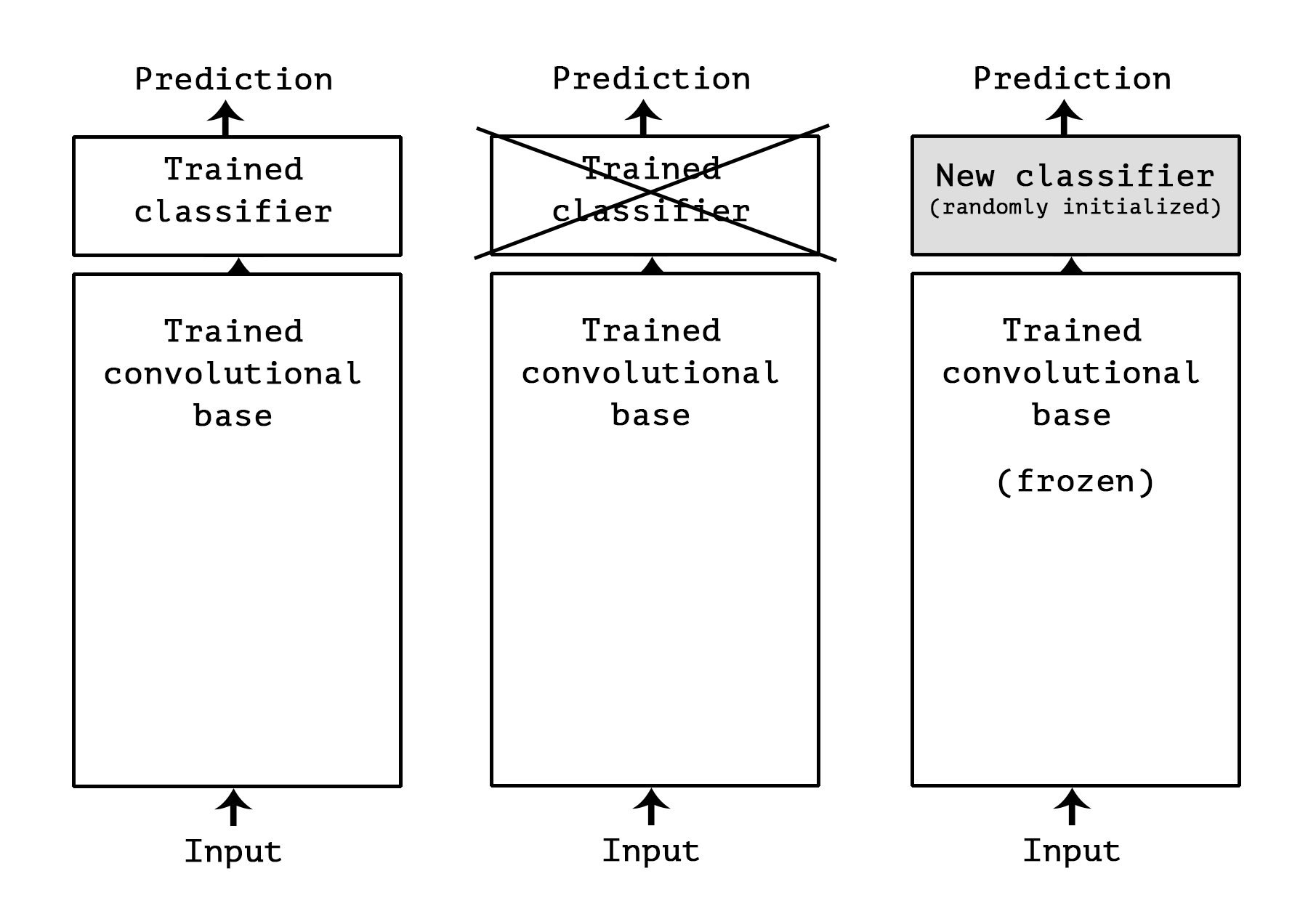
1. Instantiate the VGG16 model:
from keras.applications import VGG16 conv_base = VGG16(weights='imagenet', #Initial Weight Value include_top=False, #Is there a densely connected classifier at the top of the network input_shape=(150, 150, 3)) #Shape of the image tensor of the input network #Details of the VGG16 convolution base architecture conv_base.summary() ''' _________________________________________________________________ Layer (type) Output Shape Param # ================================================================= input_1 (InputLayer) (None, 150, 150, 3) 0 _________________________________________________________________ block1_conv1 (Conv2D) (None, 150, 150, 64) 1792 _________________________________________________________________ block1_conv2 (Conv2D) (None, 150, 150, 64) 36928 _________________________________________________________________ block1_pool (MaxPooling2D) (None, 75, 75, 64) 0 _________________________________________________________________ block2_conv1 (Conv2D) (None, 75, 75, 128) 73856 _________________________________________________________________ block2_conv2 (Conv2D) (None, 75, 75, 128) 147584 _________________________________________________________________ block2_pool (MaxPooling2D) (None, 37, 37, 128) 0 _________________________________________________________________ block3_conv1 (Conv2D) (None, 37, 37, 256) 295168 _________________________________________________________________ block3_conv2 (Conv2D) (None, 37, 37, 256) 590080 _________________________________________________________________ block3_conv3 (Conv2D) (None, 37, 37, 256) 590080 _________________________________________________________________ block3_pool (MaxPooling2D) (None, 18, 18, 256) 0 _________________________________________________________________ block4_conv1 (Conv2D) (None, 18, 18, 512) 1180160 _________________________________________________________________ block4_conv2 (Conv2D) (None, 18, 18, 512) 2359808 _________________________________________________________________ block4_conv3 (Conv2D) (None, 18, 18, 512) 2359808 _________________________________________________________________ block4_pool (MaxPooling2D) (None, 9, 9, 512) 0 _________________________________________________________________ block5_conv1 (Conv2D) (None, 9, 9, 512) 2359808 _________________________________________________________________ block5_conv2 (Conv2D) (None, 9, 9, 512) 2359808 _________________________________________________________________ block5_conv3 (Conv2D) (None, 9, 9, 512) 2359808 _________________________________________________________________ block5_pool (MaxPooling2D) (None, 4, 4, 512) 0 ================================================================= Total params: 14,714,688 Trainable params: 14,714,688 Non-trainable params: 0 _________________________________________________________________ '''
2. First method:
Run a convolution base on our dataset, save its output to disk as a Numpy array, and use the data as input to a separate densely connected classifier.
import os import numpy as np from keras.preprocessing.image import ImageDataGenerator base_dir = '/Users/Administrator/Desktop/deeplearning/02.Convolutional Neural Network/cats_and_dogs_small' train_dir = os.path.join(base_dir, 'train') validation_dir = os.path.join(base_dir, 'validation') test_dir = os.path.join(base_dir, 'test') datagen = ImageDataGenerator(rescale=1./255) batch_size = 20 def extract_features(directory, sample_count): features = np.zeros(shape=(sample_count, 4, 4, 512)) labels = np.zeros(shape=(sample_count)) generator = datagen.flow_from_directory( directory, target_size=(150, 150), batch_size=batch_size, class_mode='binary') i = 0 for inputs_batch, labels_batch in generator: features_batch = conv_base.predict(inputs_batch) features[i * batch_size : (i + 1) * batch_size] = features_batch labels[i * batch_size : (i + 1) * batch_size] = labels_batch i += 1 if i * batch_size >= sample_count: # Note that since generators yield data indefinitely in a loop, # we must `break` after every image has been seen once. break return features, labels train_features, train_labels = extract_features(train_dir, 2000) validation_features, validation_labels = extract_features(validation_dir, 1000) test_features, test_labels = extract_features(test_dir, 1000) ''' Found 2000 images belonging to 2 classes. Found 1000 images belonging to 2 classes. Found 1000 images belonging to 2 classes. ''' #Delayering train_features = np.reshape(train_features, (2000, 4 * 4 * 512)) validation_features = np.reshape(validation_features, (1000, 4 * 4 * 512)) test_features = np.reshape(test_features, (1000, 4 * 4 * 512))
Training:
Define densely connected classifiers using dropout regularization to train on the data and labels just recorded.
from keras import models from keras import layers from keras import optimizers model = models.Sequential() model.add(layers.Dense(256, activation='relu', input_dim=4 * 4 * 512)) model.add(layers.Dropout(0.5)) model.add(layers.Dense(1, activation='sigmoid')) model.compile(optimizer=optimizers.RMSprop(lr=2e-5), loss='binary_crossentropy', metrics=['acc']) history = model.fit(train_features, train_labels, epochs=30, batch_size=20, validation_data=(validation_features, validation_labels)) ''' Train on 2000 samples, validate on 1000 samples Epoch 1/30 2000/2000 [==============================] - 4s 2ms/step - loss: 0.6134 - acc: 0.6590 - val_loss: 0.4378 - val_acc: 0.8340 Epoch 2/30 2000/2000 [==============================] - 4s 2ms/step - loss: 0.4305 - acc: 0.7965 - val_loss: 0.3568 - val_acc: 0.8680 Epoch 3/30 2000/2000 [==============================] - 4s 2ms/step - loss: 0.3378 - acc: 0.8660 - val_loss: 0.3159 - val_acc: 0.8790 Epoch 4/30 2000/2000 [==============================] - 4s 2ms/step - loss: 0.3136 - acc: 0.8705 - val_loss: 0.2912 - val_acc: 0.8840 Epoch 5/30 2000/2000 [==============================] - 4s 2ms/step - loss: 0.2815 - acc: 0.8845 - val_loss: 0.2826 - val_acc: 0.8870 Epoch 6/30 2000/2000 [==============================] - 4s 2ms/step - loss: 0.2578 - acc: 0.8975 - val_loss: 0.2670 - val_acc: 0.8970 Epoch 7/30 2000/2000 [==============================] - 4s 2ms/step - loss: 0.2358 - acc: 0.9075 - val_loss: 0.2592 - val_acc: 0.8980 Epoch 8/30 2000/2000 [==============================] - 4s 2ms/step - loss: 0.2298 - acc: 0.9045 - val_loss: 0.2553 - val_acc: 0.8980 Epoch 9/30 2000/2000 [==============================] - 4s 2ms/step - loss: 0.2144 - acc: 0.9130 - val_loss: 0.2630 - val_acc: 0.8900 Epoch 10/30 2000/2000 [==============================] - 4s 2ms/step - loss: 0.1975 - acc: 0.9255 - val_loss: 0.2461 - val_acc: 0.8980 Epoch 11/30 2000/2000 [==============================] - 4s 2ms/step - loss: 0.1932 - acc: 0.9305 - val_loss: 0.2439 - val_acc: 0.8960 Epoch 12/30 2000/2000 [==============================] - 4s 2ms/step - loss: 0.1832 - acc: 0.9325 - val_loss: 0.2504 - val_acc: 0.8970 Epoch 13/30 2000/2000 [==============================] - 4s 2ms/step - loss: 0.1775 - acc: 0.9370 - val_loss: 0.2398 - val_acc: 0.9010 Epoch 14/30 2000/2000 [==============================] - 4s 2ms/step - loss: 0.1709 - acc: 0.9355 - val_loss: 0.2380 - val_acc: 0.8990 Epoch 15/30 2000/2000 [==============================] - 4s 2ms/step - loss: 0.1644 - acc: 0.9455 - val_loss: 0.2416 - val_acc: 0.9010 Epoch 16/30 2000/2000 [==============================] - 4s 2ms/step - loss: 0.1526 - acc: 0.9485 - val_loss: 0.2359 - val_acc: 0.9020 Epoch 17/30 2000/2000 [==============================] - 4s 2ms/step - loss: 0.1442 - acc: 0.9515 - val_loss: 0.2360 - val_acc: 0.9010 Epoch 18/30 2000/2000 [==============================] - 4s 2ms/step - loss: 0.1320 - acc: 0.9535 - val_loss: 0.2465 - val_acc: 0.8970 Epoch 19/30 2000/2000 [==============================] - 4s 2ms/step - loss: 0.1327 - acc: 0.9555 - val_loss: 0.2363 - val_acc: 0.8990 Epoch 20/30 2000/2000 [==============================] - 4s 2ms/step - loss: 0.1263 - acc: 0.9535 - val_loss: 0.2484 - val_acc: 0.9000 Epoch 21/30 2000/2000 [==============================] - 4s 2ms/step - loss: 0.1210 - acc: 0.9570 - val_loss: 0.2352 - val_acc: 0.8940 Epoch 22/30 2000/2000 [==============================] - 4s 2ms/step - loss: 0.1147 - acc: 0.9620 - val_loss: 0.2351 - val_acc: 0.9020 Epoch 23/30 2000/2000 [==============================] - 4s 2ms/step - loss: 0.1108 - acc: 0.9630 - val_loss: 0.2416 - val_acc: 0.8990 Epoch 24/30 2000/2000 [==============================] - 4s 2ms/step - loss: 0.1070 - acc: 0.9680 - val_loss: 0.2411 - val_acc: 0.8980 Epoch 25/30 2000/2000 [==============================] - 4s 2ms/step - loss: 0.1045 - acc: 0.9695 - val_loss: 0.2379 - val_acc: 0.9000 Epoch 26/30 2000/2000 [==============================] - 4s 2ms/step - loss: 0.1015 - acc: 0.9650 - val_loss: 0.2394 - val_acc: 0.8970 Epoch 27/30 2000/2000 [==============================] - 4s 2ms/step - loss: 0.0937 - acc: 0.9700 - val_loss: 0.2402 - val_acc: 0.8970 Epoch 28/30 2000/2000 [==============================] - 4s 2ms/step - loss: 0.0902 - acc: 0.9740 - val_loss: 0.2597 - val_acc: 0.8970 Epoch 29/30 2000/2000 [==============================] - 4s 2ms/step - loss: 0.0867 - acc: 0.9750 - val_loss: 0.2445 - val_acc: 0.8950 Epoch 30/30 2000/2000 [==============================] - 4s 2ms/step - loss: 0.0860 - acc: 0.9705 - val_loss: 0.2404 - val_acc: 0.8980 '''
View loss and accuracy curves during training:
Since this technique is not suitable for data augmentation, the model has been fitted almost from the beginning.
import matplotlib.pyplot as plt acc = history.history['acc'] val_acc = history.history['val_acc'] loss = history.history['loss'] val_loss = history.history['val_loss'] epochs = range(len(acc)) plt.plot(epochs, acc, 'bo', label='Training acc') plt.plot(epochs, val_acc, 'b', label='Validation acc') plt.title('Training and validation accuracy') plt.legend() plt.figure() plt.plot(epochs, loss, 'bo', label='Training loss') plt.plot(epochs, val_loss, 'b', label='Validation loss') plt.title('Training and validation loss') plt.legend() plt.show()
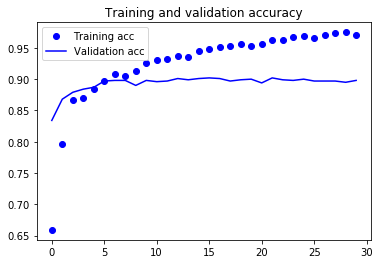
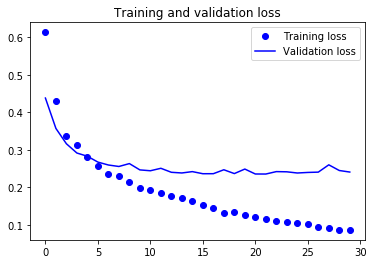
3. Second method:
Expand our conv_base model by adding a full connection layer at the top of the network and run end-to-end on the input data.
from keras import models from keras import layers model = models.Sequential() model.add(conv_base) model.add(layers.Flatten()) model.add(layers.Dense(256, activation='relu')) model.add(layers.Dense(1, activation='sigmoid')) model.summary() ''' _________________________________________________________________ Layer (type) Output Shape Param # ================================================================= vgg16 (Model) (None, 4, 4, 512) 14714688 _________________________________________________________________ flatten_2 (Flatten) (None, 8192) 0 _________________________________________________________________ dense_5 (Dense) (None, 256) 2097408 _________________________________________________________________ dense_6 (Dense) (None, 1) 257 ================================================================= Total params: 16,812,353 Trainable params: 16,812,353 Non-trainable params: 0 _________________________________________________________________ '''
Freeze convolution base:
Set its trainable property.
print('This is the number of trainable weights ' 'before freezing the conv base:', len(model.trainable_weights)) ''' This is the number of trainable weights before freezing the conv base: 30 ''' conv_base.trainable = False print('This is the number of trainable weights ' 'after freezing the conv base:', len(model.trainable_weights)) ''' This is the number of trainable weights after freezing the conv base: 4 '''
Training:
from keras.preprocessing.image import ImageDataGenerator train_datagen = ImageDataGenerator( rescale=1./255, rotation_range=40, width_shift_range=0.2, height_shift_range=0.2, shear_range=0.2, zoom_range=0.2, horizontal_flip=True, fill_mode='nearest') # Note that the validation data should not be augmented! test_datagen = ImageDataGenerator(rescale=1./255) train_generator = train_datagen.flow_from_directory( # This is the target directory train_dir, # All images will be resized to 150x150 target_size=(150, 150), batch_size=20, # Since we use binary_crossentropy loss, we need binary labels class_mode='binary') validation_generator = test_datagen.flow_from_directory( validation_dir, target_size=(150, 150), batch_size=20, class_mode='binary') model.compile(loss='binary_crossentropy', optimizer=optimizers.RMSprop(lr=2e-5), metrics=['acc']) history = model.fit_generator( train_generator, steps_per_epoch=100, epochs=30, validation_data=validation_generator, validation_steps=50, verbose=2) ''' Found 2000 images belonging to 2 classes. Found 1000 images belonging to 2 classes. Epoch 1/30 - 526s - loss: 0.5844 - acc: 0.6955 - val_loss: 0.4446 - val_acc: 0.8160 Epoch 2/30 - 520s - loss: 0.4693 - acc: 0.7885 - val_loss: 0.3661 - val_acc: 0.8700 Epoch 3/30 - 521s - loss: 0.4280 - acc: 0.8055 - val_loss: 0.3229 - val_acc: 0.8710 Epoch 4/30 - 521s - loss: 0.4052 - acc: 0.8200 - val_loss: 0.2976 - val_acc: 0.8860 Epoch 5/30 - 520s - loss: 0.3775 - acc: 0.8380 - val_loss: 0.2880 - val_acc: 0.8850 Epoch 6/30 - 521s - loss: 0.3605 - acc: 0.8430 - val_loss: 0.2758 - val_acc: 0.8930 Epoch 7/30 - 521s - loss: 0.3538 - acc: 0.8440 - val_loss: 0.2689 - val_acc: 0.8970 Epoch 8/30 - 521s - loss: 0.3415 - acc: 0.8540 - val_loss: 0.2656 - val_acc: 0.8970 Epoch 9/30 - 521s - loss: 0.3339 - acc: 0.8575 - val_loss: 0.2678 - val_acc: 0.8980 Epoch 10/30 - 521s - loss: 0.3229 - acc: 0.8595 - val_loss: 0.2750 - val_acc: 0.8810 Epoch 11/30 - 521s - loss: 0.3221 - acc: 0.8560 - val_loss: 0.2536 - val_acc: 0.8920 Epoch 12/30 - 521s - loss: 0.3250 - acc: 0.8600 - val_loss: 0.2635 - val_acc: 0.8870 Epoch 13/30 - 521s - loss: 0.3263 - acc: 0.8570 - val_loss: 0.2522 - val_acc: 0.8930 Epoch 14/30 - 521s - loss: 0.3053 - acc: 0.8685 - val_loss: 0.2505 - val_acc: 0.8890 Epoch 15/30 - 521s - loss: 0.3203 - acc: 0.8665 - val_loss: 0.2459 - val_acc: 0.9020 Epoch 16/30 - 521s - loss: 0.3107 - acc: 0.8635 - val_loss: 0.2601 - val_acc: 0.8890 Epoch 17/30 - 521s - loss: 0.2983 - acc: 0.8760 - val_loss: 0.2534 - val_acc: 0.8920 Epoch 18/30 - 520s - loss: 0.2995 - acc: 0.8780 - val_loss: 0.2457 - val_acc: 0.8970 Epoch 19/30 - 520s - loss: 0.2951 - acc: 0.8760 - val_loss: 0.2445 - val_acc: 0.8990 Epoch 20/30 - 521s - loss: 0.2912 - acc: 0.8715 - val_loss: 0.2602 - val_acc: 0.8920 Epoch 21/30 - 522s - loss: 0.2915 - acc: 0.8760 - val_loss: 0.2375 - val_acc: 0.9070 Epoch 22/30 - 521s - loss: 0.3073 - acc: 0.8610 - val_loss: 0.2387 - val_acc: 0.9060 Epoch 23/30 - 521s - loss: 0.2885 - acc: 0.8805 - val_loss: 0.2384 - val_acc: 0.9030 Epoch 24/30 - 522s - loss: 0.2868 - acc: 0.8770 - val_loss: 0.2403 - val_acc: 0.9030 Epoch 25/30 - 522s - loss: 0.2883 - acc: 0.8705 - val_loss: 0.2397 - val_acc: 0.9000 Epoch 26/30 - 521s - loss: 0.2985 - acc: 0.8700 - val_loss: 0.2415 - val_acc: 0.8980 Epoch 27/30 - 521s - loss: 0.2778 - acc: 0.8775 - val_loss: 0.2552 - val_acc: 0.8960 Epoch 28/30 - 521s - loss: 0.2842 - acc: 0.8775 - val_loss: 0.2361 - val_acc: 0.9010 Epoch 29/30 - 522s - loss: 0.2737 - acc: 0.8865 - val_loss: 0.2385 - val_acc: 0.8990 Epoch 30/30 - 522s - loss: 0.2767 - acc: 0.8745 - val_loss: 0.2423 - val_acc: 0.9000 ''' model.save('cats_and_dogs_small_3.h5')
Draw results:
acc = history.history['acc'] val_acc = history.history['val_acc'] loss = history.history['loss'] val_loss = history.history['val_loss'] epochs = range(len(acc)) plt.plot(epochs, acc, 'bo', label='Training acc') plt.plot(epochs, val_acc, 'b', label='Validation acc') plt.title('Training and validation accuracy') plt.legend() plt.figure() plt.plot(epochs, loss, 'bo', label='Training loss') plt.plot(epochs, val_loss, 'b', label='Validation loss') plt.title('Training and validation loss') plt.legend() plt.show()
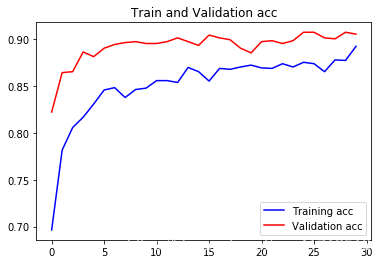
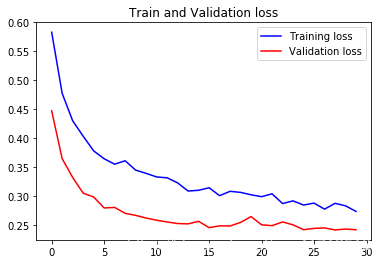
Fine tuning

Defrost some layers in the underlying network:
When feature extraction is performed, the user-defined network is added to the trained basic network, the basic network is frozen, and the part added by the training is completed.
Defrost conv_base and freeze individual layers in it.
conv_base.summary() ''' _________________________________________________________________ Layer (type) Output Shape Param # ================================================================= input_1 (InputLayer) (None, 150, 150, 3) 0 _________________________________________________________________ block1_conv1 (Conv2D) (None, 150, 150, 64) 1792 _________________________________________________________________ block1_conv2 (Conv2D) (None, 150, 150, 64) 36928 _________________________________________________________________ block1_pool (MaxPooling2D) (None, 75, 75, 64) 0 _________________________________________________________________ block2_conv1 (Conv2D) (None, 75, 75, 128) 73856 _________________________________________________________________ block2_conv2 (Conv2D) (None, 75, 75, 128) 147584 _________________________________________________________________ block2_pool (MaxPooling2D) (None, 37, 37, 128) 0 _________________________________________________________________ block3_conv1 (Conv2D) (None, 37, 37, 256) 295168 _________________________________________________________________ block3_conv2 (Conv2D) (None, 37, 37, 256) 590080 _________________________________________________________________ block3_conv3 (Conv2D) (None, 37, 37, 256) 590080 _________________________________________________________________ block3_pool (MaxPooling2D) (None, 18, 18, 256) 0 _________________________________________________________________ block4_conv1 (Conv2D) (None, 18, 18, 512) 1180160 _________________________________________________________________ block4_conv2 (Conv2D) (None, 18, 18, 512) 2359808 _________________________________________________________________ block4_conv3 (Conv2D) (None, 18, 18, 512) 2359808 _________________________________________________________________ block4_pool (MaxPooling2D) (None, 9, 9, 512) 0 _________________________________________________________________ block5_conv1 (Conv2D) (None, 9, 9, 512) 2359808 _________________________________________________________________ block5_conv2 (Conv2D) (None, 9, 9, 512) 2359808 _________________________________________________________________ block5_conv3 (Conv2D) (None, 9, 9, 512) 2359808 _________________________________________________________________ block5_pool (MaxPooling2D) (None, 4, 4, 512) 0 ================================================================= Total params: 14,714,688 Trainable params: 14,714,688 Non-trainable params: 0 _________________________________________________________________ '''
The first layer is frozen to the block4_pool layer, while the layers block5_conv1, block5_conv2, and block5_conv3 are updated for training.
conv_base.trainable = True set_trainable = False for layer in conv_base.layers: if layer.name == 'block5_conv1': set_trainable = True if set_trainable: layer.trainable = True else: layer.trainable = False ''' <keras.engine.input_layer.InputLayer object at 0x0000018C750AFA20> <keras.layers.convolutional.Conv2D object at 0x0000018C750E40F0> <keras.layers.convolutional.Conv2D object at 0x0000018C7FE9CAC8> <keras.layers.pooling.MaxPooling2D object at 0x0000018C7FF07FD0> <keras.layers.convolutional.Conv2D object at 0x0000018C7FEDB5F8> <keras.layers.convolutional.Conv2D object at 0x0000018C7FF350F0> <keras.layers.pooling.MaxPooling2D object at 0x0000018C7FF5E470> <keras.layers.convolutional.Conv2D object at 0x0000018C7FF4C2E8> <keras.layers.convolutional.Conv2D object at 0x0000018C7FF86E80> <keras.layers.convolutional.Conv2D object at 0x0000018C7FFB1438> <keras.layers.pooling.MaxPooling2D object at 0x0000018C7FFC8A90> <keras.layers.convolutional.Conv2D object at 0x0000018C06008630> <keras.layers.convolutional.Conv2D object at 0x0000018C060219B0> <keras.layers.convolutional.Conv2D object at 0x0000018C060490B8> <keras.layers.pooling.MaxPooling2D object at 0x0000018C0605EC50> <keras.layers.convolutional.Conv2D object at 0x0000018C060763C8> <keras.layers.convolutional.Conv2D object at 0x0000018C0609F048> <keras.layers.convolutional.Conv2D object at 0x0000018C060C5BE0> <keras.layers.pooling.MaxPooling2D object at 0x0000018C060F2278> '''
Start fine tuning the network:
The RMSprop optimization function with a low learning rate is used to control the updates to the output of the three-layer network features that we are fine-tuning.
from keras.models import load_model model = load_model('cats_and_dogs_small_3.h5') from keras.preprocessing.image import ImageDataGenerator model.compile(loss='binary_crossentropy', optimizer=optimizers.RMSprop(lr=1e-5), metrics=['acc']) history = model.fit_generator( train_generator, steps_per_epoch=100, epochs=100, validation_data=validation_generator, validation_steps=50) ''' Epoch 1/100 100/100 [==============================] - 71s 708ms/step - loss: 0.2964 - acc: 0.8740 - val_loss: 0.2679 - val_acc: 0.8940 Epoch 2/100 100/100 [==============================] - 69s 695ms/step - loss: 0.2588 - acc: 0.8950 - val_loss: 0.2117 - val_acc: 0.9130 Epoch 3/100 100/100 [==============================] - 70s 696ms/step - loss: 0.2290 - acc: 0.9045 - val_loss: 0.2136 - val_acc: 0.9130 Epoch 4/100 100/100 [==============================] - 69s 690ms/step - loss: 0.2251 - acc: 0.9090 - val_loss: 0.2173 - val_acc: 0.9130 Epoch 5/100 100/100 [==============================] - 69s 689ms/step - loss: 0.2254 - acc: 0.9075 - val_loss: 0.2012 - val_acc: 0.9180 Epoch 6/100 100/100 [==============================] - 69s 694ms/step - loss: 0.1914 - acc: 0.9230 - val_loss: 0.1999 - val_acc: 0.9270 Epoch 7/100 100/100 [==============================] - 69s 694ms/step - loss: 0.1788 - acc: 0.9320 - val_loss: 0.2214 - val_acc: 0.9180 Epoch 8/100 100/100 [==============================] - 69s 689ms/step - loss: 0.1718 - acc: 0.9275 - val_loss: 0.2047 - val_acc: 0.9210 Epoch 9/100 100/100 [==============================] - 69s 688ms/step - loss: 0.1522 - acc: 0.9340 - val_loss: 0.2339 - val_acc: 0.9120 Epoch 10/100 100/100 [==============================] - 69s 692ms/step - loss: 0.1413 - acc: 0.9440 - val_loss: 0.1962 - val_acc: 0.9260 Epoch 11/100 100/100 [==============================] - 69s 688ms/step - loss: 0.1683 - acc: 0.9330 - val_loss: 0.2370 - val_acc: 0.9080 Epoch 12/100 100/100 [==============================] - 69s 694ms/step - loss: 0.1428 - acc: 0.9415 - val_loss: 0.1867 - val_acc: 0.9290 Epoch 13/100 100/100 [==============================] - 69s 687ms/step - loss: 0.1289 - acc: 0.9540 - val_loss: 0.1870 - val_acc: 0.9310 Epoch 14/100 100/100 [==============================] - 69s 689ms/step - loss: 0.1386 - acc: 0.9440 - val_loss: 0.1763 - val_acc: 0.9290 Epoch 15/100 100/100 [==============================] - 69s 695ms/step - loss: 0.1281 - acc: 0.9475 - val_loss: 0.1794 - val_acc: 0.9300 Epoch 16/100 100/100 [==============================] - 69s 694ms/step - loss: 0.1126 - acc: 0.9545 - val_loss: 0.1843 - val_acc: 0.9340 Epoch 17/100 100/100 [==============================] - 69s 690ms/step - loss: 0.0951 - acc: 0.9595 - val_loss: 0.1679 - val_acc: 0.9310 Epoch 18/100 100/100 [==============================] - 69s 688ms/step - loss: 0.1109 - acc: 0.9565 - val_loss: 0.1779 - val_acc: 0.9340 Epoch 19/100 100/100 [==============================] - 69s 691ms/step - loss: 0.0944 - acc: 0.9670 - val_loss: 0.1766 - val_acc: 0.9320 Epoch 20/100 100/100 [==============================] - 69s 689ms/step - loss: 0.0942 - acc: 0.9670 - val_loss: 0.2022 - val_acc: 0.9250 Epoch 21/100 100/100 [==============================] - 69s 690ms/step - loss: 0.0921 - acc: 0.9635 - val_loss: 0.2021 - val_acc: 0.9260 Epoch 22/100 100/100 [==============================] - 69s 691ms/step - loss: 0.0825 - acc: 0.9670 - val_loss: 0.1876 - val_acc: 0.9320 Epoch 23/100 100/100 [==============================] - 69s 689ms/step - loss: 0.1010 - acc: 0.9630 - val_loss: 0.1837 - val_acc: 0.9360 Epoch 24/100 100/100 [==============================] - 69s 691ms/step - loss: 0.0847 - acc: 0.9670 - val_loss: 0.1988 - val_acc: 0.9350 Epoch 25/100 100/100 [==============================] - 69s 690ms/step - loss: 0.0731 - acc: 0.9705 - val_loss: 0.2018 - val_acc: 0.9350 Epoch 26/100 100/100 [==============================] - 69s 689ms/step - loss: 0.0827 - acc: 0.9695 - val_loss: 0.1748 - val_acc: 0.9400 Epoch 27/100 100/100 [==============================] - 69s 689ms/step - loss: 0.0722 - acc: 0.9755 - val_loss: 0.2203 - val_acc: 0.9330 Epoch 28/100 100/100 [==============================] - 69s 689ms/step - loss: 0.0680 - acc: 0.9735 - val_loss: 0.2063 - val_acc: 0.9280 Epoch 29/100 100/100 [==============================] - 69s 689ms/step - loss: 0.0654 - acc: 0.9710 - val_loss: 0.1923 - val_acc: 0.9360 Epoch 30/100 100/100 [==============================] - 69s 694ms/step - loss: 0.0733 - acc: 0.9710 - val_loss: 0.1965 - val_acc: 0.9320 Epoch 31/100 100/100 [==============================] - 69s 692ms/step - loss: 0.0708 - acc: 0.9760 - val_loss: 0.2125 - val_acc: 0.9290 Epoch 32/100 100/100 [==============================] - 69s 689ms/step - loss: 0.0669 - acc: 0.9745 - val_loss: 0.2035 - val_acc: 0.9350 Epoch 33/100 100/100 [==============================] - 69s 690ms/step - loss: 0.0679 - acc: 0.9735 - val_loss: 0.2199 - val_acc: 0.9270 Epoch 34/100 100/100 [==============================] - 69s 692ms/step - loss: 0.0628 - acc: 0.9785 - val_loss: 0.1928 - val_acc: 0.9310 Epoch 35/100 100/100 [==============================] - 69s 687ms/step - loss: 0.0664 - acc: 0.9770 - val_loss: 0.2173 - val_acc: 0.9290 Epoch 36/100 100/100 [==============================] - 69s 691ms/step - loss: 0.0515 - acc: 0.9820 - val_loss: 0.2261 - val_acc: 0.9340 Epoch 37/100 100/100 [==============================] - 69s 692ms/step - loss: 0.0555 - acc: 0.9785 - val_loss: 0.3316 - val_acc: 0.9160 Epoch 38/100 100/100 [==============================] - 69s 688ms/step - loss: 0.0558 - acc: 0.9790 - val_loss: 0.2359 - val_acc: 0.9340 Epoch 39/100 100/100 [==============================] - 69s 692ms/step - loss: 0.0400 - acc: 0.9875 - val_loss: 0.2345 - val_acc: 0.9350 Epoch 40/100 100/100 [==============================] - 69s 695ms/step - loss: 0.0504 - acc: 0.9830 - val_loss: 0.2222 - val_acc: 0.9370 Epoch 41/100 100/100 [==============================] - 69s 687ms/step - loss: 0.0437 - acc: 0.9835 - val_loss: 0.2325 - val_acc: 0.9390 Epoch 42/100 100/100 [==============================] - 69s 688ms/step - loss: 0.0455 - acc: 0.9830 - val_loss: 0.2271 - val_acc: 0.9410 Epoch 43/100 100/100 [==============================] - 69s 688ms/step - loss: 0.0557 - acc: 0.9805 - val_loss: 0.2746 - val_acc: 0.9300 Epoch 44/100 100/100 [==============================] - 69s 694ms/step - loss: 0.0450 - acc: 0.9840 - val_loss: 0.3066 - val_acc: 0.9230 Epoch 45/100 100/100 [==============================] - 69s 687ms/step - loss: 0.0536 - acc: 0.9810 - val_loss: 0.2126 - val_acc: 0.9330 Epoch 46/100 100/100 [==============================] - 69s 689ms/step - loss: 0.0477 - acc: 0.9810 - val_loss: 0.1954 - val_acc: 0.9400 Epoch 47/100 100/100 [==============================] - 69s 687ms/step - loss: 0.0360 - acc: 0.9885 - val_loss: 0.2033 - val_acc: 0.9410 Epoch 48/100 100/100 [==============================] - 69s 687ms/step - loss: 0.0405 - acc: 0.9820 - val_loss: 0.2188 - val_acc: 0.9330 Epoch 49/100 100/100 [==============================] - 68s 685ms/step - loss: 0.0318 - acc: 0.9880 - val_loss: 0.2992 - val_acc: 0.9240 Epoch 50/100 100/100 [==============================] - 69s 690ms/step - loss: 0.0308 - acc: 0.9900 - val_loss: 0.2760 - val_acc: 0.9280 Epoch 51/100 100/100 [==============================] - 69s 688ms/step - loss: 0.0429 - acc: 0.9855 - val_loss: 0.2365 - val_acc: 0.9360 Epoch 52/100 100/100 [==============================] - 69s 687ms/step - loss: 0.0435 - acc: 0.9845 - val_loss: 0.2321 - val_acc: 0.9400 Epoch 53/100 100/100 [==============================] - 69s 686ms/step - loss: 0.0306 - acc: 0.9895 - val_loss: 0.2982 - val_acc: 0.9260 Epoch 54/100 100/100 [==============================] - 69s 686ms/step - loss: 0.0406 - acc: 0.9850 - val_loss: 0.3509 - val_acc: 0.9260 Epoch 55/100 100/100 [==============================] - 69s 691ms/step - loss: 0.0374 - acc: 0.9890 - val_loss: 0.2440 - val_acc: 0.9350 Epoch 56/100 100/100 [==============================] - 69s 690ms/step - loss: 0.0313 - acc: 0.9880 - val_loss: 0.2671 - val_acc: 0.9300 Epoch 57/100 100/100 [==============================] - 69s 688ms/step - loss: 0.0264 - acc: 0.9865 - val_loss: 0.2277 - val_acc: 0.9340 Epoch 58/100 100/100 [==============================] - 69s 685ms/step - loss: 0.0286 - acc: 0.9890 - val_loss: 0.3027 - val_acc: 0.9310 Epoch 59/100 100/100 [==============================] - 69s 691ms/step - loss: 0.0332 - acc: 0.9865 - val_loss: 0.2370 - val_acc: 0.9330 Epoch 60/100 100/100 [==============================] - 69s 687ms/step - loss: 0.0251 - acc: 0.9900 - val_loss: 0.2270 - val_acc: 0.9400 Epoch 61/100 100/100 [==============================] - 69s 689ms/step - loss: 0.0345 - acc: 0.9880 - val_loss: 0.3246 - val_acc: 0.9190 Epoch 62/100 100/100 [==============================] - 69s 691ms/step - loss: 0.0360 - acc: 0.9905 - val_loss: 0.3061 - val_acc: 0.9290 Epoch 63/100 100/100 [==============================] - 69s 685ms/step - loss: 0.0405 - acc: 0.9855 - val_loss: 0.2458 - val_acc: 0.9390 Epoch 64/100 100/100 [==============================] - 69s 686ms/step - loss: 0.0241 - acc: 0.9905 - val_loss: 0.2371 - val_acc: 0.9350 Epoch 65/100 100/100 [==============================] - 68s 685ms/step - loss: 0.0223 - acc: 0.9920 - val_loss: 0.2663 - val_acc: 0.9420 Epoch 66/100 100/100 [==============================] - 69s 688ms/step - loss: 0.0325 - acc: 0.9900 - val_loss: 0.2829 - val_acc: 0.9340 Epoch 67/100 100/100 [==============================] - 69s 688ms/step - loss: 0.0319 - acc: 0.9855 - val_loss: 0.2462 - val_acc: 0.9410 Epoch 68/100 100/100 [==============================] - 68s 684ms/step - loss: 0.0314 - acc: 0.9900 - val_loss: 0.2452 - val_acc: 0.9400 Epoch 69/100 100/100 [==============================] - 69s 689ms/step - loss: 0.0217 - acc: 0.9920 - val_loss: 0.2276 - val_acc: 0.9400 Epoch 70/100 100/100 [==============================] - 69s 691ms/step - loss: 0.0316 - acc: 0.9895 - val_loss: 0.3000 - val_acc: 0.9320 Epoch 71/100 100/100 [==============================] - 69s 685ms/step - loss: 0.0235 - acc: 0.9900 - val_loss: 0.2419 - val_acc: 0.9380 Epoch 72/100 100/100 [==============================] - 68s 684ms/step - loss: 0.0254 - acc: 0.9890 - val_loss: 0.2744 - val_acc: 0.9270 Epoch 73/100 100/100 [==============================] - 69s 688ms/step - loss: 0.0213 - acc: 0.9935 - val_loss: 0.2577 - val_acc: 0.9360 Epoch 74/100 100/100 [==============================] - 69s 687ms/step - loss: 0.0234 - acc: 0.9900 - val_loss: 0.5941 - val_acc: 0.8910 Epoch 75/100 100/100 [==============================] - 69s 686ms/step - loss: 0.0229 - acc: 0.9910 - val_loss: 0.2376 - val_acc: 0.9410 Epoch 76/100 100/100 [==============================] - 68s 684ms/step - loss: 0.0269 - acc: 0.9895 - val_loss: 0.2192 - val_acc: 0.9400 Epoch 77/100 100/100 [==============================] - 69s 690ms/step - loss: 0.0306 - acc: 0.9895 - val_loss: 0.4235 - val_acc: 0.9180 Epoch 78/100 100/100 [==============================] - 69s 688ms/step - loss: 0.0297 - acc: 0.9870 - val_loss: 0.4058 - val_acc: 0.9150 Epoch 79/100 100/100 [==============================] - 68s 685ms/step - loss: 0.0185 - acc: 0.9920 - val_loss: 0.2406 - val_acc: 0.9350 Epoch 80/100 100/100 [==============================] - 68s 682ms/step - loss: 0.0231 - acc: 0.9925 - val_loss: 0.2911 - val_acc: 0.9350 Epoch 81/100 100/100 [==============================] - 68s 685ms/step - loss: 0.0210 - acc: 0.9925 - val_loss: 0.2490 - val_acc: 0.9390 Epoch 82/100 100/100 [==============================] - 68s 683ms/step - loss: 0.0285 - acc: 0.9900 - val_loss: 0.2651 - val_acc: 0.9400 Epoch 83/100 100/100 [==============================] - 69s 686ms/step - loss: 0.0238 - acc: 0.9915 - val_loss: 0.2630 - val_acc: 0.9420 Epoch 84/100 100/100 [==============================] - 69s 691ms/step - loss: 0.0139 - acc: 0.9945 - val_loss: 0.4327 - val_acc: 0.9170 Epoch 85/100 100/100 [==============================] - 70s 696ms/step - loss: 0.0318 - acc: 0.9885 - val_loss: 0.3970 - val_acc: 0.9170 Epoch 86/100 100/100 [==============================] - 69s 689ms/step - loss: 0.0212 - acc: 0.9920 - val_loss: 0.2888 - val_acc: 0.9360 Epoch 87/100 100/100 [==============================] - 69s 691ms/step - loss: 0.0271 - acc: 0.9900 - val_loss: 0.3411 - val_acc: 0.9280 Epoch 88/100 100/100 [==============================] - 69s 689ms/step - loss: 0.0168 - acc: 0.9955 - val_loss: 0.2189 - val_acc: 0.9480 Epoch 89/100 100/100 [==============================] - 70s 697ms/step - loss: 0.0233 - acc: 0.9920 - val_loss: 0.2459 - val_acc: 0.9410 Epoch 90/100 100/100 [==============================] - 69s 690ms/step - loss: 0.0224 - acc: 0.9915 - val_loss: 0.2352 - val_acc: 0.9400 Epoch 91/100 100/100 [==============================] - 70s 699ms/step - loss: 0.0189 - acc: 0.9925 - val_loss: 0.2632 - val_acc: 0.9380 Epoch 92/100 100/100 [==============================] - 69s 694ms/step - loss: 0.0163 - acc: 0.9940 - val_loss: 0.3046 - val_acc: 0.9360 Epoch 93/100 100/100 [==============================] - 69s 695ms/step - loss: 0.0099 - acc: 0.9980 - val_loss: 0.3264 - val_acc: 0.9350 Epoch 94/100 100/100 [==============================] - 69s 694ms/step - loss: 0.0174 - acc: 0.9950 - val_loss: 0.2712 - val_acc: 0.9370 Epoch 95/100 100/100 [==============================] - 69s 691ms/step - loss: 0.0132 - acc: 0.9965 - val_loss: 0.3202 - val_acc: 0.9330 Epoch 96/100 100/100 [==============================] - 69s 695ms/step - loss: 0.0126 - acc: 0.9945 - val_loss: 0.2944 - val_acc: 0.9330 Epoch 97/100 100/100 [==============================] - 70s 695ms/step - loss: 0.0236 - acc: 0.9940 - val_loss: 0.3391 - val_acc: 0.9340 Epoch 98/100 100/100 [==============================] - 69s 689ms/step - loss: 0.0241 - acc: 0.9910 - val_loss: 0.2671 - val_acc: 0.9360 Epoch 99/100 100/100 [==============================] - 69s 695ms/step - loss: 0.0231 - acc: 0.9915 - val_loss: 0.2538 - val_acc: 0.9400 Epoch 100/100 100/100 [==============================] - 69s 693ms/step - loss: 0.0219 - acc: 0.9935 - val_loss: 0.2560 - val_acc: 0.9370 ''' model.save('cats_and_dogs_small_4.h5')
Draw results:
acc = history.history['acc'] val_acc = history.history['val_acc'] loss = history.history['loss'] val_loss = history.history['val_loss'] epochs = range(len(acc)) plt.plot(epochs, acc, 'bo', label='Training acc') plt.plot(epochs, val_acc, 'b', label='Validation acc') plt.title('Training and validation accuracy') plt.legend() plt.figure() plt.plot(epochs, loss, 'bo', label='Training loss') plt.plot(epochs, val_loss, 'b', label='Validation loss') plt.title('Training and validation loss') plt.legend() plt.show()
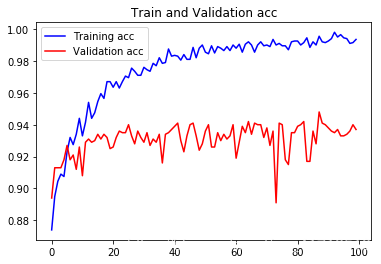
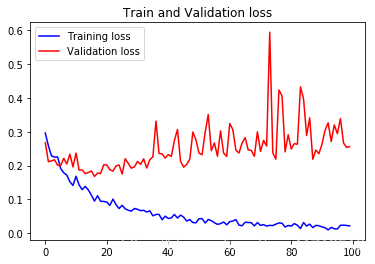
These curves look very noisy, and to make them more readable, we can smooth them by calculating the exponential moving average instead of each loss and accuracy.
def smooth_curve(points, factor=0.8): smoothed_points = [] for point in points: if smoothed_points: previous = smoothed_points[-1] smoothed_points.append(previous * factor + point * (1 - factor)) else: smoothed_points.append(point) return smoothed_points plt.plot(epochs, smooth_curve(acc), 'bo', label='Smoothed training acc') plt.plot(epochs, smooth_curve(val_acc), 'b', label='Smoothed validation acc') plt.title('Training and validation accuracy') plt.legend() plt.figure() plt.plot(epochs, smooth_curve(loss), 'bo', label='Smoothed training loss') plt.plot(epochs, smooth_curve(val_loss), 'b', label='Smoothed validation loss') plt.title('Training and validation loss') plt.legend() plt.show()

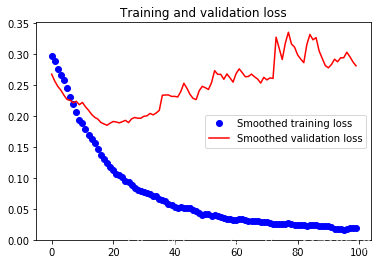
Evaluation model:
test_generator = test_datagen.flow_from_directory( test_dir, target_size=(150, 150), batch_size=20, class_mode='binary') test_loss, test_acc = model.evaluate_generator(test_generator, steps=50) print('test acc:', test_acc) ''' Found 1000 images belonging to 2 classes. test acc: 0.9730000052452088 '''
Summary
1.convnet is the best machine learning model for computer vision tasks.Even on a very small dataset, you can start training from scratch and get impressive results.
2. Overfitting will be the main problem on small datasets.Data expansion is a powerful way to combat over-fitting when processing image data.
3. Feature extraction makes it easy to use an existing convnet on a new dataset.This is also a very valuable technique for processing small image data sets.
4. As a supplement to feature extraction, fine-tuning can also be used to apply some of the features learned from existing models to new problems, which can further improve performance.

